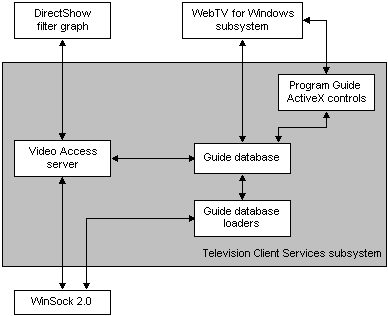
[This is preliminary documentation and subject to change.]
The following sections briefly describe the components of the Television Client Services subsystem. This subsystem includes a database called the Guide database. Other components in this subsystem use the Guide database to control Microsoft WebTV for Windows and the DirectShow filter graph. The following illustration shows how the components of the Television Client Services subsystem fit together.

The Video Access server is a Broadcast Architecture component that runs on the broadcast client as a separate process. It handles device contention among multiple instances of the Microsoft® WebTV® for Windows® ActiveX control.
The Program Guide Microsoft® ActiveX® controls are Broadcast Architecture components. These controls display the user interface for the Program Guide. For information on the Program Guide, see Overview of Program Guide Services.
The Guide database is a Broadcast Architecture component. A Microsoft® Jet database, it stores current information about broadcast television programs from various broadcast networks. For more information on the Guide database, see Overview of Program Guide Services.
Guide database loaders are Broadcast Architecture components. In addition to the loaders provided, the Television Client Services subsystem also supports the use of third-party loaders. Generally, a vendor of Program Guide information furnishes a vendor-written loader to the broadcast client when a user subscribes to that vendor's service.
These loaders process incoming Program Guide data and load it into the Guide database. The software supporting the Broadcast Architecture Programmer's Reference includes a skeleton loader as an example for third-party developers. For more information on database loaders, see Updating the Guide Database. To locate the loader sample application, see Broadcast Architecture Sample Applications.